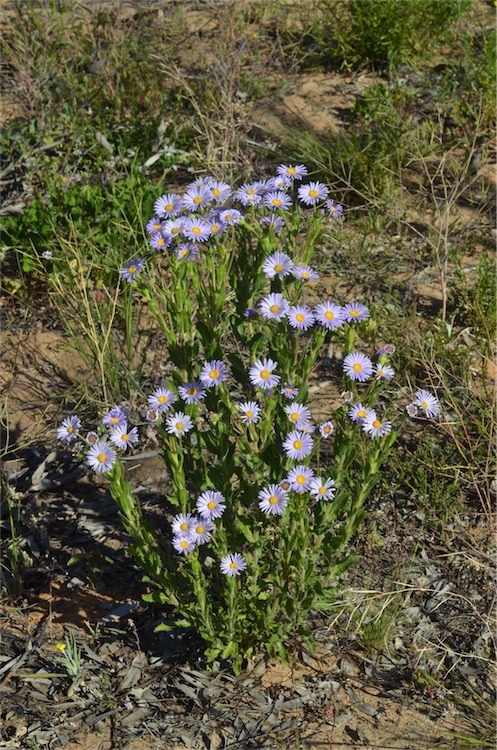|
Olearia Rudis
''Olearia rudis'', commonly known as azure daisy-bush, is a species of flowering plant in the family Asteraceae and is endemic to eastern Australia. It is a usually short-lived shrub with crowded elliptic or egg-shaped leaves, and pale blue, mauve or purple and orange, daisy-like inflorescences. Description ''Olearia rudis'' is a stiff, usually short-lived shrub or subshrub that typically grows to a height of up to about , its branchlets usually bristly-hairy. It has crowded elliptic or egg-shaped leaves with the narrower end towards the base, long and wide. Both surface of the leaves are bristly-hairy, the edges are often serrated, and the base is slightly stem-clasping. The heads or daisy-like "flowers" are arranged singly or in corymbs on the ends of branches or in leaf axils on a peduncle and are in diameter. Each head has 40 to 75 pale blue, mauve or purple ray florets, the ligule long, surrounding 60 to 250 orange disc florets. Flowering occurs from July to October ... [...More Info...] [...Related Items...] OR: [Wikipedia] [Google] [Baidu] |
Benth
George Bentham (22 September 1800 – 10 September 1884) was an English botanist, described by the weed botanist Duane Isely as "the premier systematic botanist of the nineteenth century". Born into a distinguished family, he initially studied law, but had a fascination with botany from an early age, which he soon pursued, becoming president of the Linnaean Society in 1861, and a fellow of the Royal Society in 1862. He was the author of a number of important botanical works, particularly flora. He is best known for his taxonomic classification of plants in collaboration with Joseph Dalton Hooker, his ''Genera Plantarum'' (1862–1883). He died in London in 1884. Life Bentham was born in Stoke, Plymouth, on 22 September 1800.Jean-Jacques Amigo, « Bentham (George) », in Nouveau Dictionnaire de biographies roussillonnaises, vol. 3 Sciences de la Vie et de la Terre, Perpignan, Publications de l'olivier, 2017, 915 p. () His father, Sir Samuel Bentham, a naval architect, ... [...More Info...] [...Related Items...] OR: [Wikipedia] [Google] [Baidu] |
Flora Of South Australia
Flora (: floras or florae) is all the plant life present in a particular region or time, generally the naturally occurring ( indigenous) native plants. The corresponding term for animals is ''fauna'', and for fungi, it is ''funga''. Sometimes bacteria and fungi are also referred to as flora as in the terms ''gut flora'' or ''skin flora''. Etymology The word "flora" comes from the Latin name of Flora, the goddess of plants, flowers, and fertility in Roman mythology. The technical term "flora" is then derived from a metonymy of this goddess at the end of the sixteenth century. It was first used in poetry to denote the natural vegetation of an area, but soon also assumed the meaning of a work cataloguing such vegetation. Moreover, "Flora" was used to refer to the flowers of an artificial garden in the seventeenth century. The distinction between vegetation (the general appearance of a community) and flora (the taxonomic composition of a community) was first made by Jules Thurman ... [...More Info...] [...Related Items...] OR: [Wikipedia] [Google] [Baidu] |
Flora Of New South Wales ...
*''The Flora that are native to New South Wales, Australia''. :*''Taxa of the lowest rank are always included. Higher taxa are included only if endemic''. *The categorisation scheme follows the World Geographical Scheme for Recording Plant Distributions, in which :* Jervis Bay Territory, politically a Commonwealth of Australia territory, is treated as part of New South Wales; :* the Australian Capital Territory, politically a Commonwealth of Australia territory, is treated as separate but subordinate to New South Wales; :* Lord Howe Island, politically part of New South Wales, is treated as subordinate to Norfolk Island. {{CatAutoTOC New South Wales Biota of New South Wales New South Wales ) , nickname = , image_map = New South Wales in Australia.svg , map_caption = Location of New South Wales in AustraliaCoordinates: , subdivision_type = Country , subdivision_name = Australia , established_title = Before federation , es ... [...More Info...] [...Related Items...] OR: [Wikipedia] [Google] [Baidu] |
Asterales Of Australia
Asterales () is an order of dicotyledonous flowering plants that includes the large family Asteraceae (or Compositae) known for composite flowers made of florets, and ten families related to the Asteraceae. While asterids in general are characterized by fused petals, composite flowers consisting of many florets create the false appearance of separate petals (as found in the rosids). The order is cosmopolitan (plants found throughout most of the world including desert and frigid zones), and includes mostly herbaceous species, although a small number of trees (such as the '' Lobelia deckenii'', the giant lobelia, and '' Dendrosenecio'', giant groundsels) and shrubs are also present. Asterales are organisms that seem to have evolved from one common ancestor. Asterales share characteristics on morphological and biochemical levels. Synapomorphies (a character that is shared by two or more groups through evolutionary development) include the presence in the plants of oligosacch ... [...More Info...] [...Related Items...] OR: [Wikipedia] [Google] [Baidu] |
Olearia
''Olearia'', most commonly known as daisy-bush, is a genus of flowering plants belonging to the family Asteraceae, the largest of the flowering plant families in the world. Olearia are found in Australia, New Guinea and New Zealand. The genus includes herbaceous plants, shrubs and small trees. The latter are unusual among the Asteraceae and are called tree daisies in New Zealand. All bear the familiar daisy-like composite flowerheads in white, pink, mauve or purple. Description Plants in the genus ''Olearia'' are shrubs of varying sizes, characterised by a composite flower head arrangement with single-row ray florets enclosed by small overlapping bracts arranged in rows. The flower petals are more or less equal in length. The centre of the bi-sexual floret is disc shaped and may be white, yellowish or purplish, generally with 5 lobes. Flower heads may be single or clusters in leaf axils or at the apex of branchlets. Leaves may be smooth, glandular or with a sticky secretio ... [...More Info...] [...Related Items...] OR: [Wikipedia] [Google] [Baidu] |
Mallee Woodlands And Shrublands
Mallee Woodlands and Shrublands is one of 32 List of Major Vegetation Groups in Australia, Major Vegetation Groups defined by the Australian Government Department of the Environment and Energy. Description "Mallee (habit), Mallee" refers to the growth habit of a group of (mainly) eucalypt species that grow to a height of , have many stems arising from a lignotuber and have a leafy canopy that shades 30–70% of the ground. The term is also applied to a vegetation association where these mallee eucalypts grow, on land that is generally flat without hills or tall trees and where the climate is semi-arid. Of the 32 Major Vegetation Groups classified under the National Vegetation Information System, "Mallee Woodlands and Shrublands" (MVG14): * are semi-arid areas dominated by mallee eucalypts; * may also have co-dominant species of ''Callitris'', ''Melaleuca'', ''Acacia'' and ''Hakea''; * have an open tree or shrub layer with more than 10% foliage cover and more than 20% Crown (bota ... [...More Info...] [...Related Items...] OR: [Wikipedia] [Google] [Baidu] |
Binomial Nomenclature
In taxonomy, binomial nomenclature ("two-term naming system"), also called nomenclature ("two-name naming system") or binary nomenclature, is a formal system of naming species of living things by giving each a name composed of two parts, both of which use Latin grammatical forms, although they can be based on words from other languages. Such a name is called a binomial name (which may be shortened to just "binomial"), a binomen, name or a scientific name; more informally it is also historically called a Latin name. The first part of the name – the '' generic name'' – identifies the genus to which the species belongs, whereas the second part – the specific name or specific epithet – distinguishes the species within the genus. For example, modern humans belong to the genus '' Homo'' and within this genus to the species '' Homo sapiens''. '' Tyrannosaurus rex'' is likely the most widely known binomial. The ''formal'' introduction of this system of naming species is ... [...More Info...] [...Related Items...] OR: [Wikipedia] [Google] [Baidu] |
Flora Australiensis
''Flora Australiensis: a description of the plants of the Australian Territory'', more commonly referred to as ''Flora Australiensis'', and also known by its standard abbreviation ''Fl. Austral.'', is a seven-volume flora of Australia published between 1863 and 1878 by George Bentham, with the assistance of Ferdinand von Mueller. It was one of the famous Kew series of colonial floras, and the first flora of any large continental area that had ever been finished. In total the flora included descriptions of 8125 species.Orchard, A. E. 1999. Introduction. In A. E. Orchard, ed. ''Flora of Australia - Volume 1'', 2nd edition pp 1-9. Australian Biological Resources Study Bentham prepared the flora from Kew; with Mueller, the first plant taxonomist residing permanently in Australia, loaning the entire collection of the National Herbarium of Victoria to Bentham over the course of several years. Mueller had been dissuaded from preparing a flora from Australia while in Australia by Benth ... [...More Info...] [...Related Items...] OR: [Wikipedia] [Google] [Baidu] |
Swan River Colony
The Swan River Colony, also known as the Swan River Settlement, or just Swan River, was a British colony established in 1829 on the Swan River, in Western Australia. This initial settlement place on the Swan River was soon named Perth, and it became the capital city of Western Australia. The name was a '' pars pro toto'' for Western Australia. On 6 February 1832 the colony was renamed the Colony of Western Australia, when the colony's founding lieutenant-governor, Captain James Stirling, belatedly received his commission. However, the name "Swan River Colony" remained in informal use for many years afterwards. European exploration The first recorded Europeans to sight land where the city of Perth is now located were Dutch sailors. Most likely the first visitor to the Swan River area was Frederick de Houtman on 19 July 1619, travelling on the ships and . His records indicate he first reached the Western Australian coast at latitude 32°20', which is approximately at Wa ... [...More Info...] [...Related Items...] OR: [Wikipedia] [Google] [Baidu] |
Enumeratio Plantarum Quas In Novae Hollandiae Ora Austro-occidentali Ad Fluvium Cygnorum Et In Sinu Regis Georgii Collegit Carolus Liber Baro De Hügel
''Enumeratio plantarum quas in Novae Hollandiæ ora austro-occidentali ad fluvium Cygnorum et in sinu Regis Georgii collegit Carolus Liber Baro de Hügel'' is a description of the plants collected at the Swan River colony and King George Sound in Western Australia. The author, Stephan Endlicher, used a collection arranged by Charles von Hügel to compile the first flora for the new settlements. Hugel visited the region during 1833–1834, several years after the founding of the colony. The work provided formal descriptions, in Latin, of new species and genera of plants. The single instalment was produced in Europe by Endlicher in 1837, the work also included contributions by Eduard Fenzl, George Bentham, Heinrich Wilhelm Schott Heinrich Wilhelm Schott (7 January 1794 in Brünn (Brno), Moravia – 5 March 1865 at Schönbrunn Palace, Vienna) was an Austrian botanist well known for his extensive work on aroids (Araceae). He studied botany, agriculture and chemistry ....see ... [...More Info...] [...Related Items...] OR: [Wikipedia] [Google] [Baidu] |





